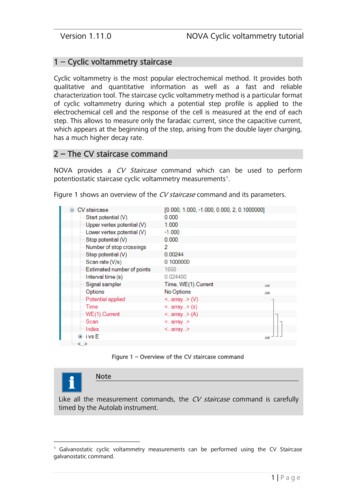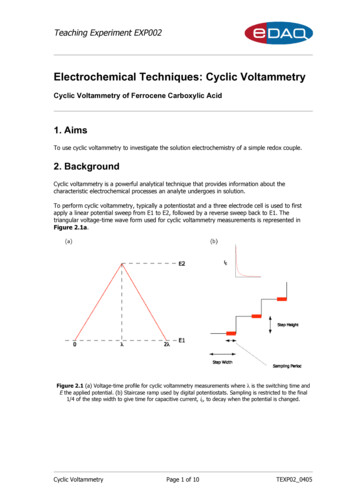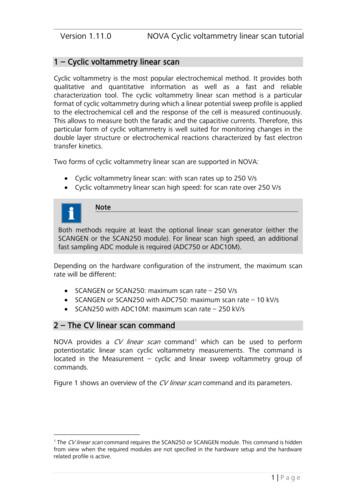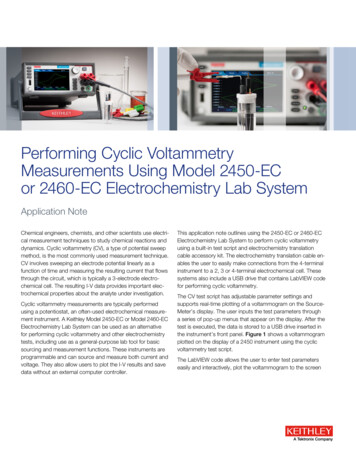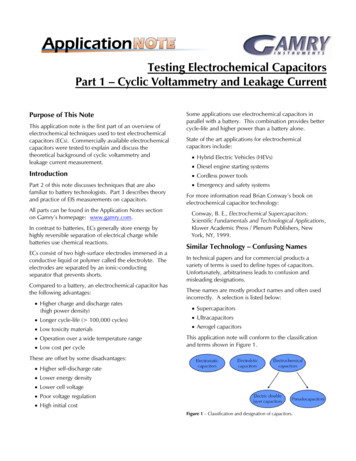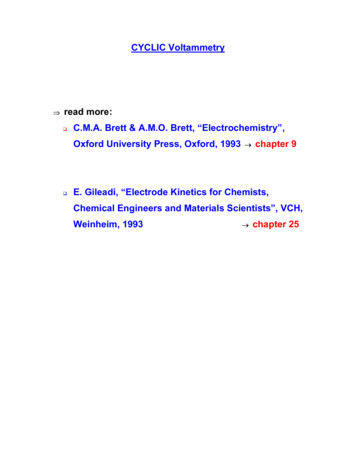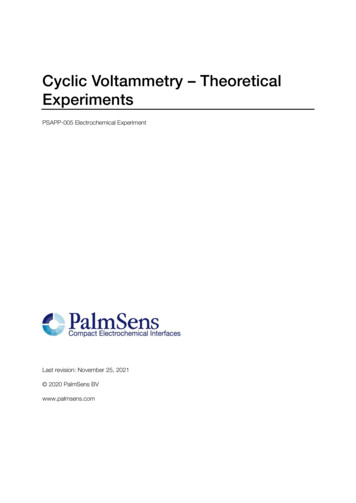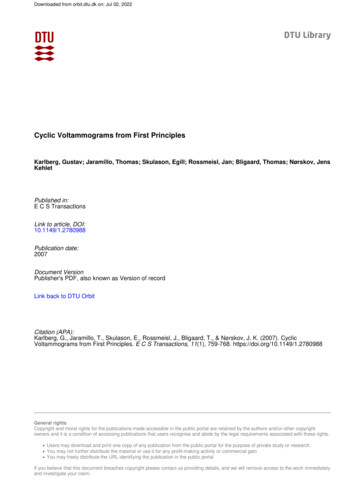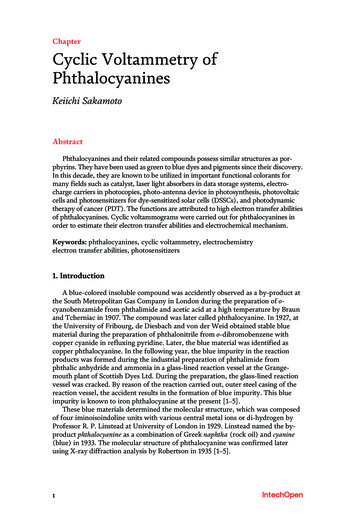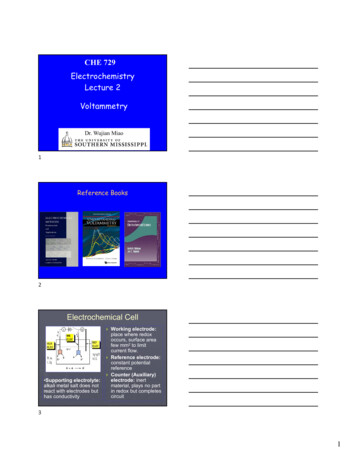
Transcription
CHE 729ElectrochemistryLecture 2VoltammetryDr. Wujian Miao1Reference Books2Electrochemical Cell Supporting electrolyte:alkali metal salt does notreact with electrodes buthas conductivityWorking electrode:place where redoxoccurs, surface areafew mm2 to limitcurrent flow.Reference electrode:constant potentialreferenceCounter (Auxiliary)electrode: inertmaterial, plays no partin redox but completescircuit31
Electrochemical Instrumentation4Voltammetry Electrochemistry techniques based oncurrent (i) measurement as function ofvoltage (Eappl)Voltammetry — Usually when the workingelectrode is solid, e.g., Pt, Au, GC.Polarograph — A special term used for thevoltammetry carried out with a (liquid)MURCURY electrode.Voltammogram — The plot of the electrodecurrent as a function of potential.5Linear sweep voltammetry The potential is varied linearly with time withsweep rates v ranging from 10 mV/s to about1000 V/s with conventional electrodes and up to106 V/s with ultramicroelectrodes (UMEs). It is customary to record the current as afunction of potential, which is equivalent torecording current versus time. Linear sweep voltammetry, linear scanvoltammetry (LSV), or linear potential sweepchronoamperometry.62
x 0X 0x (“bulk”)(Ox ne Red) (reversible)7Linear Sweep/Scan VoltammetryPeak-shaped i E profile8For A e A- reversible reaction, E0(A/A-) E0(1) E E0, i 0(2) E E0 dE, i 0, increases(3) E E0, i 0, [A] [A-] [A*]/2(4) E E0 - 28.5 mV, i maximum, [A]x 0 0.25[A*](5) E E0, i 0, decreases, as the depletion effectA e A E E0 RT[A]lnnF [A ]where E E 0 , [A] [A ]x 0DigiSim demonstration93
Cyclic Voltammetry (CV) Potential: E(t) Ei - t (V), 0 t E(t) Ei - 2 t (V), t CV is not an ideal method for quantitative evaluation ofsystem properties. It is powerful in qualitative and semiquantitative reaction behavior.DigiSim demonstration10Cyclic Voltammetry- i vs timeDigiSim demonstration11NERNSTIAN (REVERSIBLE) SYSTEMSSemi-infinite linear diffusion, only O exist initiallyLSV: potential changes linearly at a sweep rate of v (\//s) Nernst equation E (t ) E 0' nF CO (0, t )lnRT CR (0, t )CO (0, t ) nF ( Ei t E 0' ) S (t ) exp CR (0, t )RT S (t ) e t , (nF / RT )v; exp (nF / RT )( Ei E 0' ) 124
Mass Transfer/TransportFor a Nernst process:vrxn vmt i / nFA flux (J )vrxn : net rate of electrode reactionvmt : rate of mass transferi: current; A: area of electrodeJ unit : mole cm-2 s-1itotal id im icIf use short times ( 10 s) and don’t stir (quiescent),then itotal id im1314Nernst-Planck Equation(governing the mass transport to an electrode) C x zF CJ x D x RTDiiiDiffusioniii x C i x xMigrationConvectionJi(x) flux of species i at distance x from electrode (mole cm-2 s-1)Di diffusion coefficient (cm2/s) Ci(x)/ x concentration gradient at distance x from electrode (x)/ x potential gradient at distance x from electrode (x) velocity at which species i moves (cm/s)“-”: flux direction opposites the concentration gradient change155
If We Use High Concentration of GoodElectrolyte in Quiescent Solution.Nernst-Planck Equation reduces to.Fick’s First Law Flux of substance is proportional toits concentration gradient: J0 x, t i x, t D o C o xnF Ai.e., flux concentration gradient16LSV Reversible SystemAfter the Laplace transformation and a series ofmathematical treatments of the diffusion equations:( (nF / RT ) )where ( t ) is a pure number at any given pointand can be solved numerically.𝜒 [“kai”]17Excel Calculation of t My Excelcalculation0.446295186
0.5 n(E-E1/2) (mV)19Reversible system{ ( t )}max 0.4463 when n(E - E 0 ) 28.5mV20Peak current and potential Peak current ipF 3 1/2 3/2) n ACO * DO1/2 1/2RT (2.69 105 )n 3/2 ACO * DO1/2 1/2 at 25 C.ip 0.4463(ip v1/2Units: Amperes, cm 2, cm 2/s, mol/cm 3, V/s Peak potential EpEp E1/2 28.5 / n (mV) at 25 CE1/ 2 E 0' ( RT / nF ) ln( DR / DO )1/ 2 Ep is independent of scan rate.217
o ne RCurrent i (A)E0’Ep E1/2 1.109 RT /nF 28.5/n mV @ 25 CEp/2 E1/ 2 1.109 RT /nF E1/ 2 28.5/n mV @ 25 CE1/ 2 E 0' DRTln( R )1/ 2 E 0'nFDoE (mV, vs. ref electrode) Ep Ep/2 2.22 RT /nF 57.0/n mV @ 25 CEp f ( v )ip f (v1/2 )22Cyclic Voltammetry23Cyclic Voltammogramsfor a Reversible Reaction ipc / ipa 1.0RT)nF 57 mV/n at 25 o C(independent of the scan rate) ( Epa Epc ) 2(1.109 E 0' ( Epa Epc ) / 2 ip constant n 3/2 ADo1/2co*v1/2(at 25 o C, constant 2.69 105 )248
Diffusion ControlledReversible ProcessFor electrode adsorption processip v25Peak separation potentials, although close to 57mV, are slightly a function of switching potentials.26Reversibility of Electrochemical System Canbe Changed via the Change of Scan Rate / lamdaAt small v (or long times),systems may yield reversiblewaves, while at large v (orshorttimes),irreversiblebehavior is observed.f nF/RT279
Electron Transfer Rate k 0k 0 , E p , i p 28Totally Irreversible System(NO Reversal Peak)29CV Applications in DiagnosingChemical Reaction MechanismsEC Reaction (Electron Transfer followed by A Chemical Reaction3010
EC Reaction: Scan Rate Dependent(a) At Fast Scan Rate(b) At Slow scan Rate31ECE ProcessO RS TO R(2nd S T)(S T)T ST S(a) S is more difficult to reducethan O (i.e., E0’S E0’O)(b) S is easier to reducethan O (i.e., E0’S E0’O)32Multi-step Systems O n1e R1 (E10)R1 n2e R2 (E20) E0 E20 - E10 E 0 (2 RT / F ) ln 2 36mVThe CV looks the sameas one electron-transferprocess. E0: (a) -180 mV; (b) -90 mV;(c) 0 mV; (d) 180 mV.3311
Ohmic Potential, IR Drop Potential change (drop) due to electrochemicalsolution resistance Eir IRI—current of the electrochemical cell,R—resistance of the electrolyte solution. Ecell Ecathode-Eanode- IR Question: In electrochemical study, an inertelectrolyte is always added to the analytesolution. Why?34A e BAR 0 Ep 58 mVR 10 Ohm Ep 100 mVcA 1 mM50 mV/sArea 1 cm235Faradaic and Nonfaradaic ProcessesFaradaic Charges or electrons are transferredacross the electrode electrolyte interfaceas a result of electrochemical reactions Governed by Faraday’s lawQ nFN A where n # of e transferedF Faraday constant (96, 485 C/mol)N A # of moles of electroactive speciesi dQdN A nFdtdt3612
Nonfaradaic Process Charges associated with movement ofelectrolyte ions, reorientation of solventdipoles, adsorption/desorption of species,etc. at the electrode electrolyteinterface. Changes with changing potential andsolution composition Charges do not cross the interface butexternal currents can still flow Regarded as “background current”37diffuse layercompact inner layerNonfaradaic Processes and the nature ofelectrode electrolyte interface; the Double layer Electrons transferred at electrode surfaceby redox reactions occur at liquid/solidinterface (heterogeneous) (1) A compact inner layer (d0 d1) (2) a diffuse layer (d1 –d2)38Charging current ic10-40 F/cm2Potential dependent3913
Equivalent Circuits of Electrochemical CellCSCE Cd40RC Circuit-Voltage Ramp (Potential Sweep)ic f(v)E vt ERS ECdvt Rs (dq / dt ) q / Cdif q 0 at t 0i vCd [1 exp( t / Rs Cd )]41General Equivalent CircuitOverall current I ic ifSignal-to-noise ratio (SNR) ificSNR , limit of detection (LOD) 4214
Cyclic Voltammetryic vCd [1 exp( t / RsCd )](ic v; t , ic )if 2.69 10 5 n 3/2 ADOx1/2COx v1/2pc(ifpc v1/2 )1v1/2 small at fast v and low CSNR v dE/tific LOD of CV 10-5 -10-6 MItotal43How do we eliminate thecharging current so thatelectrochemical techniques couldbe used in quantifying lowconcentrations of redox species?(Pulse Voltammetry)44RC Circuit-Potential StepI 5% (E/Rs) at t 3 RsCd time constant in s 4515
(A-)(A)A is reduced to A- at potential E2This kind of experiment is calledchronoamperometry, because currentis recorded as a function of time.46Cottrell Equation c ci D o ( o ) x 0 D o ( o ) x 0 , δ Dt xnFAδ**c 0c 0D c* Do( o) Do( o) o o δ Dt*1/ 2 *DcnFADo coi nFA o o 1/ 2t1/ 2 Dt47Curves 1, 2, 3, Co(0, t) not 0-not diffusion controlled(electrode reaction-controlled)4816
Sampled Current Voltammetry(Normal Pulse Voltammetry)49Eliminating ic: Potential Step/Pulse Voltammetry EPotential Eiftic Staircase VoltammetryWhen applying E :ic Eexp( t / RsCd ) ic e tRs*nFADOxCOx if t 1/2 tat , ic 0, so SNR if (t ) sample point(LOD 10-8 M)TimeNormal Pulse VoltammetryDifferential Pulse Voltammetry50Additive Cyclic Square Wave Voltammetry (ACSWV)icF icfa icfc2H 1icFjicR icra icrcj'icR4H 1Total additive I cI c icF icR 0icfa : forward anodic icfaciicfc : forward cathodic icicra : reverse anodic ic icfcicrc : reverse cathodic ic5117
52Pulse Voltammetric Techniques All pulse techniques are based on the differencein the rate of the decay of the charging and thefaradaic currents following a potential step (or"pulse").ich nFA DCo* E texp(); if (Cottrell Eq.)RsRs Cd t The rate of decay: ich much faster than if.-- ich isnegligible at a time of 5RsCd (time constant, µsto ms) after the potential step. The sampled i consists solely of the faradaiccurrent.53Important parameters Pulse amplitude: the height of the potentialpulse. This may or may not be constantdepending upon the technique. Pulse width: the duration of the potential pulse. Sample period: the time at the end of the pulseduring which the current is measured.5418
StaircasePolarography/Voltammetry55Digital potentiostats use a staircase wave form asan approximation to a linear wave form. Thisapproximation is only valid when E is small ( 0.26 mV) and analog current integration filteringis used.56Normal PulsePolarography/Voltammetry5719
58Differential Pulse Voltammetry (DPV)596020
Square Wave Voltammetry (SWV)61Peak Current: 1 for large pulse amplitudes62Charging current (smaller more than an order of magnitudethan that of NPV) with LOD 10 nM.C60 reductions6321
Square Wave Voltammetry (SWV)64656622
SWV Response67686923
Comparison between SWV and CVSWV Strengths Low electrochemicalbackground. Much low detectionlimit. Much less distortionof voltammogrameasy to fit theoreticaldata. Better for evaluatingquantitativeparameters.CV Strengths More intuitively inchemical terms for mostpractitioners. Reversal of CV coversa large span of E—more readily highlightslinkages b/w processesoccurring at widelyseparated potentials. Wider range of timescales.70Applications of Voltammetry Dopamine detectionin mice brains Au or Si NPs redoxbehavior 71Anodic Striping Voltammetry (ASV)Principle of anodic stripping. (a) Preelectrolysis at Ed; stirred solution,(b) Rest period; stirrer off. (c) Anodic scan.7224
ASV-Electrode DependencePyrolytic graphiteHMDEPolished GCUnpolished GC73Sensitivity and Limit Detection7425
2 Electrochemical Instrumentation Voltammetry Electrochemistry techniques based on current (i)measurement as function of voltage (Eappl) Voltammetry —Usuallywhen the working electrode is solid, e.g., Pt, Au, GC. Polarograph —A special term used for the voltammetry carried out with a (liquid)
